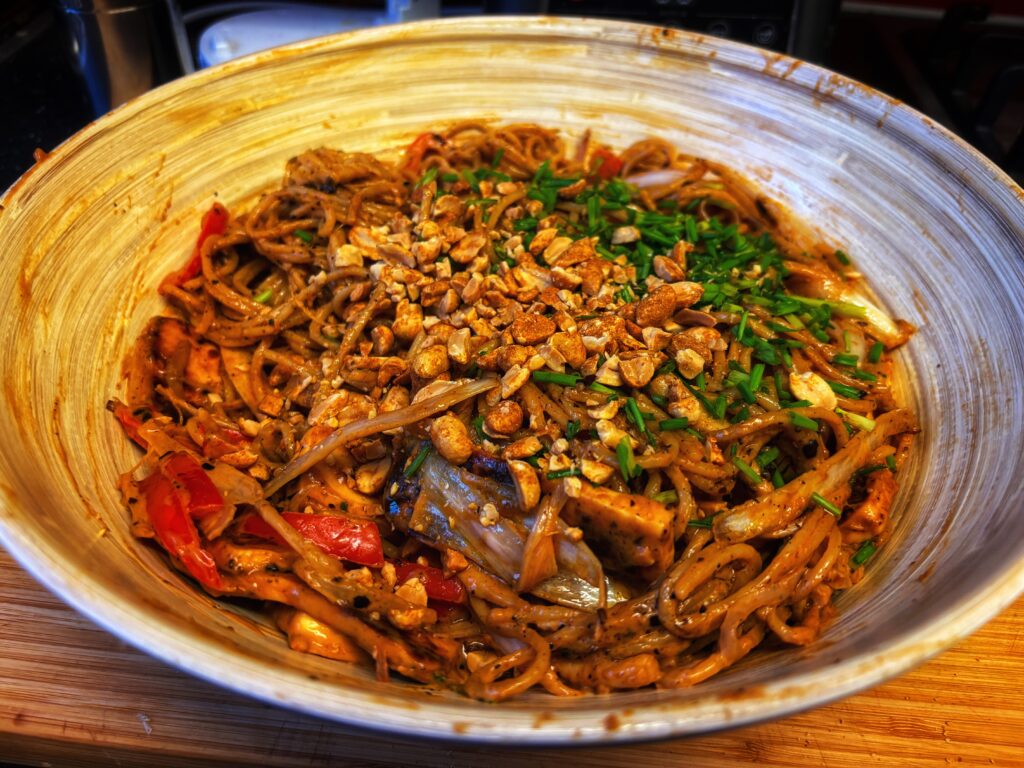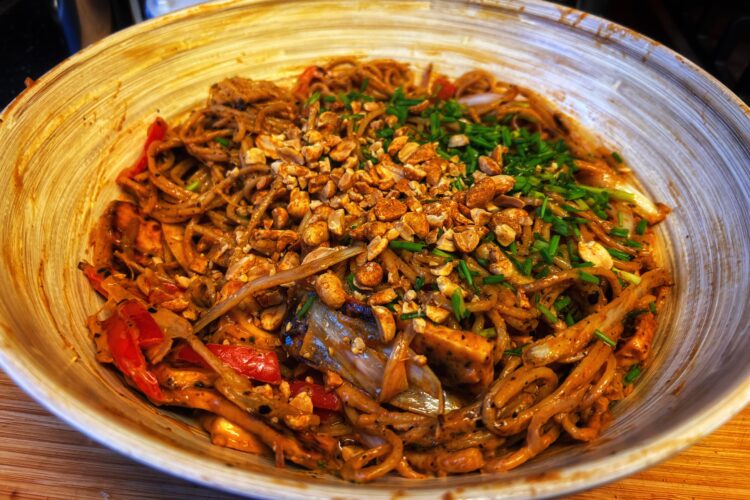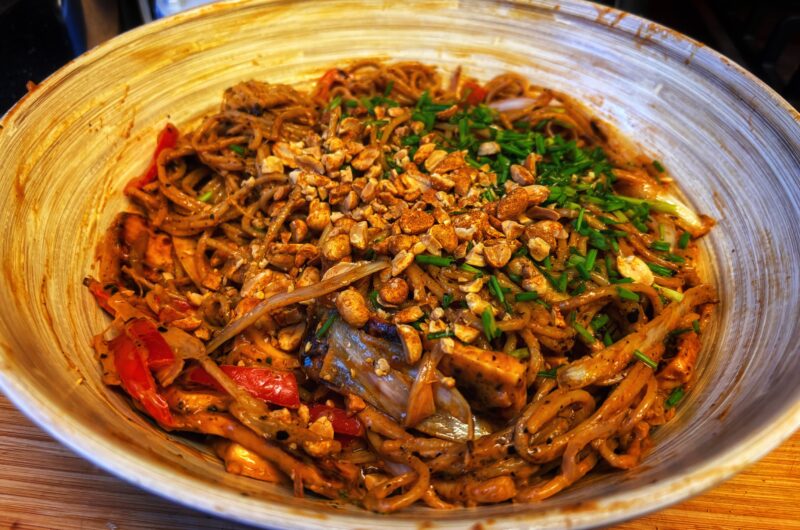This delicious, Sichuan chilli oil peanut noodles; believe it or not; is irresistible, protein-packed, quick & healthy
Skip to these parts:
When you think of noodles, the instant thought is a highly-processed food that your kid is somehow obsessed with. However, what if this very noodles could actually be a health food? Packed with protein from peanuts and paneer/tofu, healthy fats and tons of flavour, this chilli oil noodles will soon become a weekly dinner staple.
This noodles is inspired by the viral scallion oil noodles. However, this does not even involve frying scallions. Though it uses a bit more oil that what you would like in your everyday meal, the best part of this recipe is the ease of customisation. You can easily modify these chilli oil peanut noodles to create a version that uses far lesser amount of oil.
Evolution of Chili Oil Peanut Noodles: Is it Authentic?
While many of you might have seen the viral scallion oil noodle videos, very few of them actually acknowledge that these noodles have their roots in the age-old Sichuan cuisine from China. The addition of peanuts is inspired by Indonesian cuisine, that uses an irresistible peanut sauce in most dishes.
Sichuan cuisine is famous for its use of numbing chillies. The practice of infusing oils with chillies reportedly date back to the late Ming Dynasty, as early as the 1600s. This is when chilli was first brought over from Latin America.
Many might argue that these Chilli Oil Peanut Noodles are a modern take on the popular Dan Dan Noodles. However, who told us that the dish has to be authentic in order to be irresistible?
Some might argue that modifying food is cultural appropriation while others might argue that it takes the real experience away. But my take on this has firmly been that food that is enjoyed and celebrated grows and popularises. Cuisines that evolve to accommodate dietary requirements, availability of ingredients and taste palates are often the ones that are touted as comfort foods across the world.
As a case in point, the varying pizza recipes that grew popular around the world ensured that this Italian food became the definition of parties, gatherings and comfy nights around the world. Different modifications of Chinese classics like spring rolls, noodles and fried rice made Chinese food the epitome of comfort takeaways around the world.
Access, information and the politics of authenticity
As social media gained popularity and travelling became less exclusive, we built narratives around the importance of authenticity. While I am not against authentic food, I believe that authentic dishes and comforting modifications can exist side by side.
Not everyone has either the time or the access to source authentic ingredients for regular family meals. However, I believe that in this globalised world all of us (and our kids) crave foods from different cuisines. Incorporating these in daily meals is a fine balance of aunthenticity, dietary requirements, accessibility and sustainability. When we learn the use of versatile ingredients and close substitutes from the nearby supermarket to make global cuisines, we not just honour our palates and bodies but also prevent wastage.
On that vein, find my guide on substituting chili peppers in food based on your tolerance for heat and the peppers available near you.
So, the next time you crave some chilli oil peanut noodles, don’t let popular narratives tell you its not authentic. And trust me, you will crave these irrestible Sichuan-inspired noodles all the time!
Chilli Oil Peanut Noodles: What you need
Sourcing god quality noodles is essential for making indulgent noodles. Additionally, great noodles ensures that you can safely use this dish as a part of weekly meal rotation. Another factor for deciding the type of noodles you want to use is the mouthfeel that you desire. These peanut noodles are equally good with thick, chewy udon noodles, glassy sweet potato noodles, flat hand-pulled rice noodles or thin and glutinous wheat noodles. If you don’t have noodles, even a high quality spaghetti such as De Cecco Spaghetti works well.
However, my absolute favourite are the thick and chewy udon noodles. The sauce coats perfectly on these noodles and makes the meal a truly indulgent one. I love the Itsu udon noodles and keep buying it in bulk!
If you buy and us peanut butter as often as I do, I suggest brands that do not contain palm oil. Lately, I’ve been buying Pip & Nut Smooth Peanut Butter and love the consistency as well as how clean the ingredients are.
Lastly, one of the most important ingredients is the chilli oil. I 100% recommend making your own chilli oil. However, I also get that it might not always be possible or let face it, you just might not want to! In that case, I recommend Laoganma Crispy chilli oil.
For the sauce
🔸6 tbsp peanut butter
🔸7 tbsp light soy sauce
🔸5 tbsp rice vinegar
🔸2 tbsp chilli oil
🔸2 tsp white sesame seeds
The noodles, protein and veggies
🔸 4 serves of udon noodles (125 g cooked / 80 g uncooked per serve)
🔸 2 carrots, chopped into 2-inch batons
🔸 1.5 red or yellow bell pepper, julienned
🔸 200 g scallion heads (the white parts), thinly sliced
🔸 250 g paneer or tofu, thinly sliced
🔸 1 tbsp vegetarian oyster sauce
🔸 1 tbsp light soy sauce
For the garnish and toppings
🔸 4 tbsp chopped chives (or 3 tbsp chopped scallion greens)
🔸 3 tbsp crushed roasted peanuts
🔸 1 tsp Chinese 5-spice powder
🔸 2 tbsp chopped coriander
Chilli Oil Peanut Noodles: Managing Dietary Requirements
Make it vegan: This recipe is naturally 100% vegan. While I sometimes add paneer as a protein (and provide this as an option in my recipe), tofu is the preferred choice of protein for this recipe.
Make it gluten-free: This peanutty and umami sauce pairs exceptionally well with chewy rice noodles. Peanuts are also gluten-free. However, most Chinese soy sauce use wheat as an ingredient. Additionally, the chances of cross-contamination is very high even if wheat is not an active ingredient. Therefore, I suggest shopping from an exclusively gluten-free range. Lee Kum Kee makes gluten-free sauces that are free from contamination.
This recipe is not suitable for people with a nut allergy. However, you might want to check out other noodle recipes that are easily nut-free and just as healthy and indulgent.
Chilli Peanut Noodles Recipe

1️⃣ Prepare the base for the sauce
In a large bowl, add the peanut butter, light soy sauce and the rice vinegar. Use the back of your spoon to mix it well till it forms a smooth slurry.
2️⃣ Prepare the vegetables
In a pan, add 2 tbsp sesame oil (or substitute with any other neutral oil). Saute the vegetables for about 30 seconds on a high flame, tossing it ocassionally. Add a tsp of salt. This helps to cook them and also retain the crunch. Set this aside.
3️⃣ Prepare the protein
Thinly slice 250 g of your chosen protein. I use a medium firm tofu for this recipe.
Heat a pan 2 tsp of neutral oil (I use olive oil). Brush the oil well to spread it evenly on the pan. Add the thinly sliced paneer or tofu and splash on the light soy sauce and vegetarian oyster sauce. Cook on a high heat and flip every 2-3 minutes to ensure all the sides are well caramelised.
4️⃣ Prepare the noodles
Heat water in a large pot. Once the water comes to a boil, add 2 tbsp salt and the uncooked udon noodles. Cook it based on the instructions on the back of the pack. Retain one cup of the noodles water and drain the rest.
5️⃣ Bring everything together
Add a splash of the noodles water to the saucy slurry. Combine well till it forms a smooth sauce. Next, add the the cooked veggies, the tofu/paneer and a tsp of Chinese 5-spice. Mix everything well.
Now add the noodles. to the sauce, the veggies and the protein.
6️⃣ Add the chilli oil
Heat the chilli oil in a pan with 2 tsp sesame seeds. Once the oil sizzles and the sesame seeds pop, take the oil off the heat and pour it on the noodles.
Toss well to combine.
7️⃣ Garnish and serve
Garnish with chives, roughly chopped roasted peanuts and coriander leaves. Serve it fresh or pack it for a lunch at work.
Chilli oil peanut Noodles | A 20-minute dinner delight
Course: MainCuisine: ChineseDifficulty: Easy4
servings10
minutes15
minutesIngredients
- For the sauce
6 tbsp peanut butter
7 tbsp light soy sauce
5 tbsp rice vinegar
2 tbsp chilli oil
2 tsp white sesame seeds
- The noodles, protein and veggies
4 serves of udon noodles (125 g cooked / 80 g uncooked per serve)
2 carrots, chopped into 2-inch batons
1.5 red or yellow bell pepper, julienned
200 g scallion heads (the white parts), thinly sliced
250 g paneer or tofu, thinly sliced
1 tbsp vegetarian oyster sauce
1 tbsp light soy sauce
- For the garnish and toppings
4 tbsp chopped chives (or 3 tbsp chopped scallion greens)
3 tbsp crushed roasted peanuts
1 tsp Chinese 5-spice powder
2 tbsp chopped coriander
Directions
- In a large bowl, add the peanut butter, light soy sauce and the rice vinegar. Use the back of your spoon to mix it well till it forms a smooth slurry.
- In a pan, add 2 tbsp sesame oil (or substitute with any other neutral oil). Saute the vegetables for about 30 seconds on a high flame, tossing it ocassionally. Add a tsp of salt. This helps to cook them and also retain the crunch. Set this aside.
- Thinly slice 250 g of your chosen protein. I use a medium firm tofu for this recipe.
Heat a pan 2 tsp of neutral oil (I use olive oil). Brush the oil well to spread it evenly on the pan. Add the thinly sliced paneer or tofu and splash on the light soy sauce and vegetarian oyster sauce. Cook on a high heat and flip every 2-3 minutes to ensure all the sides are well caramelised. - Heat water in a large pot. Once the water comes to a boil, add 2 tbsp salt and the uncooked udon noodles. Cook it based on the instructions on the back of the pack. Retain one cup of the noodles water and drain the rest.
- Add a splash of the noodles water to the saucy slurry. Combine well till it forms a smooth sauce. Next, add the the cooked veggies, the tofu/paneer and a tsp of Chinese 5-spice. Mix everything well.
Now add the noodles. to the sauce, the veggies and the protein. - Heat the chilli oil in a pan with 2 tsp sesame seeds. Once the oil sizzles and the sesame seeds pop, take the oil off the heat and pour it on the noodles.
Toss well to combine. - Garnish with chives, roughly chopped roasted peanuts and coriander leaves. Serve it fresh or pack it for a lunch at work.
Notes
- Make it vegan: This recipe is naturally 100% vegan. While I sometimes add paneer as a protein (and provide this as an option in my recipe), tofu is the preferred choice of protein for this recipe.
- Make it gluten-free: This peanutty and umami sauce pairs exceptionally well with chewy rice noodles. Peanuts are also gluten-free. However, most Chinese soy sauce use wheat as an ingredient. Additionally, the chances of cross-contamination is very high even if wheat is not an active ingredient. Therefore, I suggest shopping from an exclusively gluten-free range. Lee Kum Kee makes gluten-free sauces that are free from contamination.
If you love this recipe but don’t have time for all the frill, try the 5-minute peanut noodles from the working Lunch series. It’s so simple that you can even make it on your lunch break on a work-from-home day!
Let me know your favourite noodles in the comments below.


